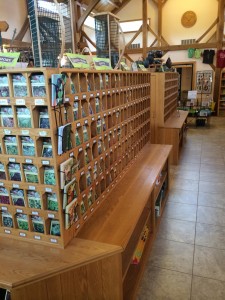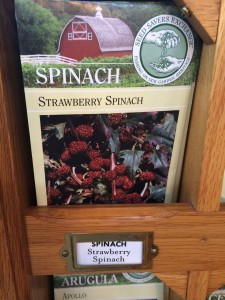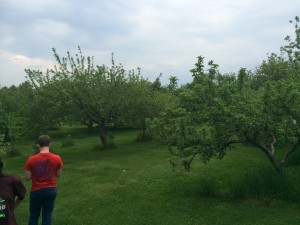We basically just spent most of the day in a car (6 hours). It may not have been fun for us, but I’m sure much less fun for the teacher driving us across Iowa. First we had a meeting with the crop insurance agent who actually insured the crops ont he farm on which we are staying at to understand how it all works. My understanding came to that they use your history to say how many bushels or corn or soy you can expect in an average year, and to determine the rate for the farmer’s premium. They then offer subsidized options for protection from yield losses compared to some percent of your historical norm (10 yrs back) or protection from market changes spring to fall (you get reimbursed for corn going down 2 dollars during the year). In addition to the federally subsidized crop insurance program, our presenter also spoke a bit about private insurance products that farmers purchase, namely hail and wind insurance. Hail and wind insurance are regulated like other insurance products by the State of Iowa. Hail and wind insurance products vary in price, bu the federal crop insurance does not–those prices are set by the federal government..
From there we took the three-hour drive to Decorah, Iowa where we visited Seed Savers. Exchange. It’s basically a giant repository operation that collects, stores, trades, and sells thousands of old breeds of seeds for crops and flowers. They have:
lots of seeds. For example, our guide, Toby said that in the US there have been some 16,000 different varieties of apple. Seeds can be traded between members using their catalog and once their online catalog is up then folks can buy those that they have enough seeds of from almost anyone. Since seeds can’t be stored forever and growing the number of seeds makes it possible to start selling them, they grow out the vegetables from time to time. Right now they have over 900 apple varieties growing there in two orchards. Many of the apple varieties in the orchard pictured below were apples cultivated before 1900.
They also have two nice gardens and a few heirloom chicken and cow breeds, with turkeys coming later.
I think seed savers was really cool and really like the idea of preserving the diverse mix of crops that have been developed over the years for future use in the ways they were intended. Some of these seeds were cultivated for taste, some were better acclimated to certain areas, others were pest or weed resistant, and then some were bred just to look cool (we heard Hereford pigs were bred just to look like Hereford cows). I find it really cool to have these varieties around and safely stored for the future, even if I personally believe that folks should try to get the breeds that work best in their area with normal breeding or buying instead of getting some of the foreign developed ones that they had (traditional German, Italian, and Mexican varieties as well as old America natives).
After that we went for another three hour car ride to Iowa city and are now happily at a little Marriott for the night. During this ride we also watched a movie about Fred Kirschenmann who is one of the earlier sustainable ag people who did it on a large scale (~3000 acres). I felt he was talking about sustainable ag vs industrial as if things had been proven and things are to my knowledge still more opinion than fact, even if I agree with what he’s doing. Most importantly is how he essentially demonized industrial ag, and I feel that doing so only causes a bigger divide whereas providing solid, quantitative evidence of the benefits of sustainable ag as well as the harms of industrial ag (if there are any, which I feel there are) will be convincing enough to slowly transition to a new kind of agriculture. The same applies for the majority of his soon to be published paper from soil to sustainability, which I read before bed. I believe it makes a lot of good points such as agriculture’s high dependence on limited resources like oil and potassium which will only be increasing in rarity and price (oil production was estimated to have peaked in the 70s by the way, although I’m not positive if it was confirmed to have). They provided some scientific backings, such as the work of Liebman at ISU who has been studying the benefits of sustainable ag practices like cover cropping. My only real issue is how uncompromising it is with changing industrial agriculture. Every other farmer we’ve seen in Iowa has been very reasonable and is happy to farm their way, and let others farm their own way and that’s true of sustainable and conventional farmers. I just feel that it’s something that will make his work more polarizing and the issue less compromising and positively viewed.





